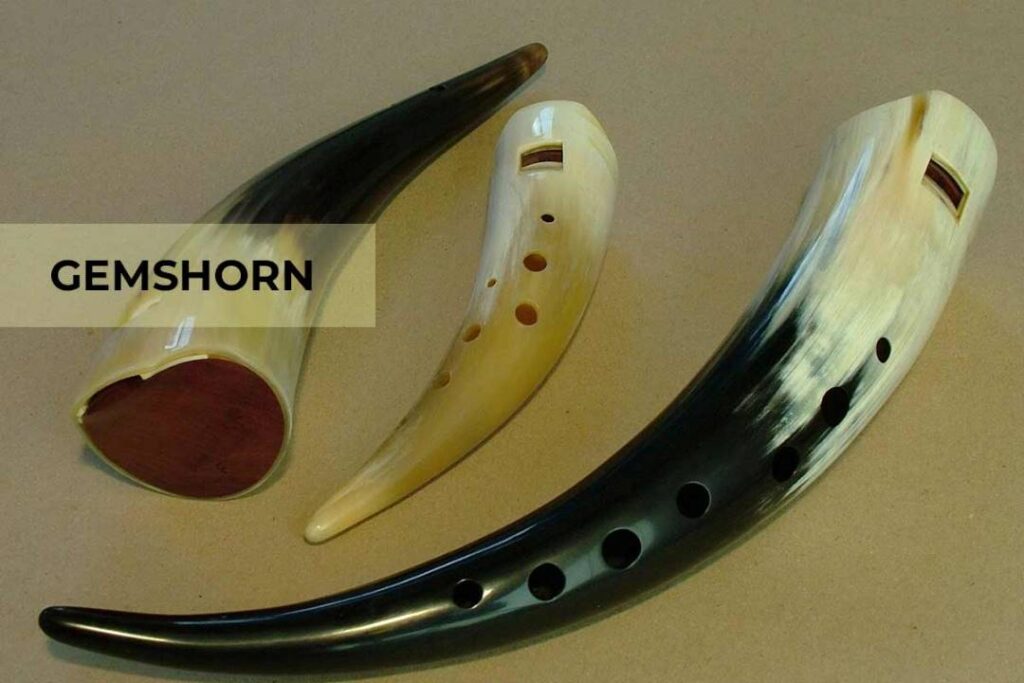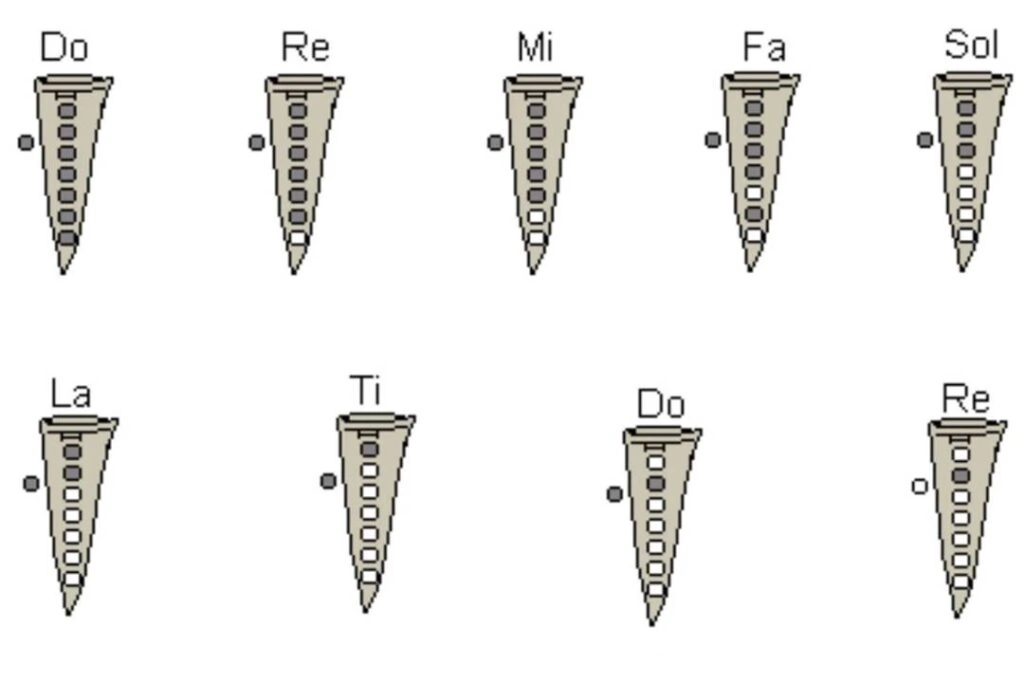Gemshorn – All You Need To Know In 7 Minutes

Gemshorn
The gemshorn is a wind and ancient instrument made from a piece of animal horn. For these reasons, it is sometimes called the horn flute.
Specifically, gemshorn is locally made from the horn of the goat, gems, or chamois. As revealed by some discoveries and contemporary images, clay was even used to make some gems.
This instrument probably came from Germany. We can say that because that is where most records of its existence came from. In fact, gemshorn means “chamois horn” in German.
A gemshorn is somewhat like an ocarina. This is because it has an enclosed space with a fipple mouthpiece.
The horn instrument is also like the recorder. The reason is that they both have fipple mouthpieces like a whistle and seven finger holes.
Some musicians referred to it as a recorder made from animal horn. But gemshorns are basically capped flutes.
Thus, they are more of a vessel flute like an ocarina than a tabular flute like a recorder.
In addition, gemshorns do not produce harmonic overtones like other vessel flutes. This aspect makes them more of a type of ocarina.
What Is a Gemshorn?
We can define the Gemshorn as a flute-like instrument made with an animal horn. The Gemshorn belongs to an end-blown fipple pipe instrument like the recorder.
A gemshorn is a fipple wind musical instrument made from the horn of gems or chamois (in German), goats, or clay.
The name gemshorn came from the horn of a gem, or chamois, which is used to make the instrument.
Gems is written as Gämsen in modern German, and it is a kind of European mountain goat.
The gemshorn is conical in shape, with a closed wide end and a smaller space for the blow hole. The blow hole is where the player blows through to play the instrument.
The gemshorn also has about seven (7) smaller finger holes along its body. Finger holes are generally used to change the pitch of the sound the instrument produces.
All gemshorns sound differently from one another. This happens because of the difference in the materials used to make them.
Moreover, gemshorns look alike because of the mode of construction. But when it comes to sound, every gemshorn is absolutely unique.
The reason being that the horns they are made from are not uniform is a different aspect of their formation.
History of The Gemshorn
Several musical instruments have been made with horns that go back a thousand years ago. However, most of them are blown from the sharp end of the horn, unlike the gemshorn.
Typically, the gemshorn used a fipple mouthpiece and was blown at the open and wider end of the horn. As a result, we cannot call any of them gemshorn or associate them with gemshorn.
The gemshorn is most likely a medieval instrument to some extent. The instrument enjoyed some popularity in the late Middle Ages and Renaissance periods. But that declined around 1550.
But not so much was said about Gemshorn during different periods or eras of music history. During those times, there were no serious music pieces written for this instrument.
As a result, the early history of the gemshorn is not well established. But we understand that this instrument appeared in the 15th century.
Some archeological discoveries proved the existence of gemshorn to be around the 15th century.
This instrument is also mentioned in some of the works of notable European musicians.
To some extent, this evidence can be used to validate the existence of the gemshorn in the 15th century. We will discuss these two pieces of evidence later in the following section.
Archeological Evidence of Gemshorn In Ochsenfeld
From an archaeological find in Ochsenfeld, there is a veritable horn instrument.
The piece of the instrument was found under a half-timbered house. The house was dated around 1454 or 1455.
They presumed that the horn-like instrument was under the ground before the house.
The instrument is a 158 mm long baked clay instrument. It has four finger holes on the front and a thumb hole on the back.
It also had another cut-out sound or tuning hole on the back. The presumed tuning hole is not far from the horn tip.
The latter was presumably re-cut, maybe to tune the fundamental tone of the instrument.
The instrument is intact and can still be blown on. It allows people to see the topological features of the instrument.
It also provides another opportunity to study the instrument further.
For instance, there is an opportunity to examine the acoustic properties of the instrument.
With all the holes on the instrument, a chromatic scale of one octave can be played comfortably.
Gemshorn’s Evidence in Published Works
This conical instrument is mentioned in the works of some notable musicians.
The first evidence of gemshorn appears in the work of Sebastian Virdung. Sebastian Virdung was a German composer and theorist of musical instruments. He called the book Musica Getutscht und Ausgezogen and published it in 1511.
Sebastian Virdung described an object in the book as “a short, curved animal horn, with four finger holes.”
Some of the instruments, like the gemhorn, were also described in the works of Martin Agricola.
Martin Agricola was a German Renaissance musician and music theorist.
He published the book in 1529 and called it “Musica instrumentalis deudsch”.
In addition, the gemshorn-like instrument was also mentioned in the Scottish book “The Complaynt of Scotlande.” The author published the book in 1549.
In the book it is referred to as “ane gatehorn,” which means goat horn.
However, we don’t know if it is a horn blowing from the sharp end or the wide end, like a gemshorn.
Chamois Horn in Latium
In 1908, in Latium, there was a known chamois horn from Central Italy. The age of that ancient instrument at that time is unknown.
However, the state of preservation makes it quite possible that the instrument was no longer new when it was found.
It can be seen that it had already survived somewhere for a long time. This may even be an archaeological finding.
This chamois horn is 175 mm long. The instrument is made from the tip of a sheep’s horn.
It was probably originally equipped with four front finger holes and a thumb hole.
However, the second and third finger holes of the instrument have broken off in a gap.
Modern Germshorn
In 1913, the musicologist Curt Sachs discovered two animal horns in the Berlin armoury.
One of them had finger holes and was converted into a flute. Specifically, by means of an inserted block and a cut on the open side of the horn.
So, we have a horn with a fipple mouthpiece and finger holes.
Consequently, the gemshorn came back to life with his innovation. Remember, the instrument had fallen into oblivion before Sachs’ innovation.
The chamois horn revived by Sachs is now in a museum in Berlin. Specifically, the “Musical Instrument Museum of the State Institute for Music Research”.
The instrument is a 330 mm long, ringed goat horn with a missing thumb hole and six front finger holes.
Horace Fitzpatrick Contribution
Horace Fitzpatrick also made worthy contributions after Curt Sachs in 1913.
He dealt with the chamois horn again for the first time in the 1960s. That was during the course of the revival of the so-called “early music” period.
Horace Fitzpatrick “reconstructed” an instrument with eight finger holes. The instrument adopted the fingering method of recorders and was built in different registers.
In addition, he produced the instrument in consort families. The Horace Fitzpatrick chamois horn instrument became a popular instrument in the early music scene. And since the 1960s, the instruments have proven very popular.
Gemshorn In the Organ Stop
Gemshorn was not popular in the serious music of its era. This was due to its size, materials, limited dynamic and limited pitch range.
However, this blocked and inverted-cone instrument found its way to survive in an organ stop. Of course, there is a gemshorn in the organ stop as a useful flute stop.
The organ stop is presumed to have been created to imitate the actual instrument it is named after.
The organ pipes for the stop are constructed in such a way that the wind enters through the wide side of the pipe. This is just like we have it in the original Gemshorn.
The organ stop named “Gemshorn” is classified as a flute and string hybrid.
The organ stop called “gemshorn” has different variations. The variations range from Double Gemshorn, Gemshorn Fifteenth, and Echo Gemshorn.
It also has a Gemshorn Octave and a Super-Gemshorn variation.
Gemshorn Construction
The gemshorn is majorly made from animal horns. To make this ancient instrument, the horn is well prepared and cut to the desired length. The length is actually determined by the pitch we want to create.
Basically, the tip of the horn is completely preserved while the open end is cut and well dressed.
Thereafter, the opening is properly sealed with suitable materials. Wood or clay are commonly used for this purpose.
However, a little space is always made available for blowing. The space is sometimes shaped into a beak or fipple shape. The beak, or fipple shape, makes blowing through the instrument easier for the player.
The space for the tone holes is determined and drilled along the body of the horn.
The tone holes are normally drilled where the fingers can easily reach them.
This makes the opening and closing of the tone holes easy for the player.
In the same manner, the labium is drilled into the horn. Typically, at a point near the edge of the open end of the horn.
The horn of Gemshorn is not commercially used to make Gemshorn again in today’s world.
The horns of other animals like cows or oxen are commonly used. These horns are readily available and assist in saving the lives of wild species.
Moreover, wood and other synthetic materials have recently been used to make the instrument.
How to Make Your Own Gemshorn
You have probably decided to make your own Gemshorn. You can try it out.
Watch the video above to see how you can make the gemshorn. The video is a good guide to making your own instrument.
If you are out of cow horns at the moment, you can use other materials.
For this purpose, hollow wood or plastic pipes with one end closed will suffice. Just follow the basic principle of making the gemshorn.
And make sure you follow what is suitable for the material you are using.
How to Play the Gemshorn
The gemshorn is played by blowing through the hole at the wide edge of the instrument. This action will create a distinct sound with the instrument.
Various tones can be produced with the instrument by opening and closing the tone holes. The different combinations of open and closed holes produce different tones.

The fingering used to play the gemshorn is like a recorder. It is usually tuned to C or F.
But unlike the recorder, the gemshorn cannot be overblown. Its inability to overblow the instrument limits the range of its sound.
What Does Gemshorn Sound Like?
The sound produced by the Gemshorn is very similar to the sound of a flute. But its sound lacks harmonic overtones just like that of an ocarina.
The tone of this closed-horn instrument has a sweet colour. The colour is somewhere between an ocarina and a soft recorder.
But the closed construction of the instrument limits the range of its sound. But the closed construction also allows a warm sound on the instrument.
Furthermore, the Gemshorn can be built at a very low pitch in this manner. Consequently, this allows for a wide ensemble of the instrument.
The instrument is very impressive with its haunting and delicate sound. Shepherds of the time may have used the gentle tones of this instrument to calm animals.
At Phamox Music, we go all out for exactness and honesty. For this purpose, if by any means you found any possible glitch, be it factual, editorial, or something that we need to update, kindly contact us.
If you find the information provided in this post, Gemshorn, interesting and helpful, kindly share it with someone you know that might need it.







